Bracciano Castle: Isabella de Medici and Paolo Giordano Orsini - love, betrayal, murder, legends
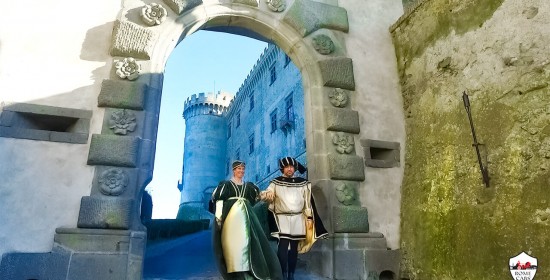
Buongiorno and welcome to RomeCabs, Rome’s top-rated tour company for private Italy tours.
Welcome to Bracciano Castle (Castello Orsini-Odescalchi), one of the most beautiful castles in Italy that you can visit. Just 1 hour from Rome and from Civitavecchia, you can visit Bracciano Castle from Rome or on a Shore Excursion from Civitavecchia.
Once a Medieval stronghold transformed into a Renaissance masterpiece by Napoleone Orsini in the late 1400s, Bracciano Castle has witnessed centuries of power struggles. Initially owned by the formidable Orsini family until the late 17th century, the castle eventually came under the possession of the Odescalchi family, who still maintains ownership today.
Amidst the backdrop of palace intrigue that was no stranger to the Orsini family and the Castle of Bracciano, legends and myths have been woven into the historical tapestry over the years. One of the most captivating tales involves the ill-fated love story of Isabella de Medici and Paolo Giordano which unfolded as a narrative veiled in scandal, adultery, and eventual crime of passion.
In this blog, we will delve into the betrayal, murder, and legends surrounding Isabella de Medici and Paolo Giordano Orsini of Bracciano—stories that have resonated through centuries. Furthermore, we will explore recently unearthed private letters that not only rewrite history but also illuminate the myths that have long defined the narrative of this renowned Renaissance couple.
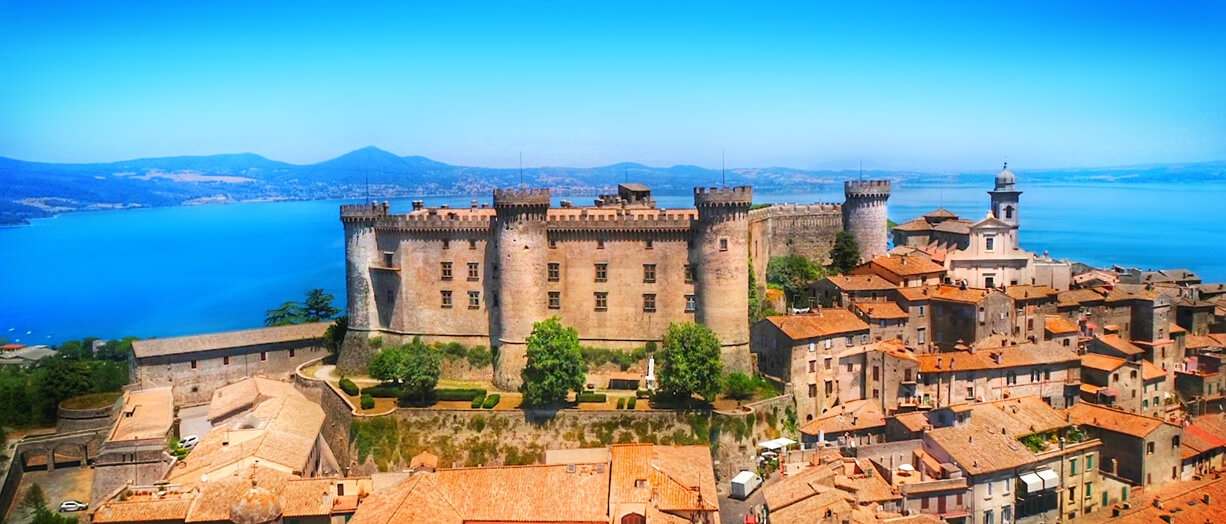
Isabella de Medici and Paolo Giordano Orsini: Legends of Betrayal and Murder
Isabella, hailing from the influential Medici family, was wedded to Paolo Giordano Orsini, the Duke of Bracciano. Their betrothal was arranged when they were just 11 and 12 years old, and they were married a few years later while still teenagers.
One legend spanning centuries suggested that her passionate affair with her husband’s cousin, Troilo Orsini, surfaced, leading to a chain of events culminating in a brutal and mysterious murder at the hands of Paolo, consumed by jealousy.
Yet another haunting legend paints Isabella de Medici as a femme fatale within the confines of Bracciano Castle. In this chilling narrative, Isabella is rumored to have lured her illicit lovers to her private chamber, the present-day Hall of the Orsini Frieze. In a sinister twist, she allegedly murdered them, casting her lovers through a trapdoor into a pit of blades and lime.
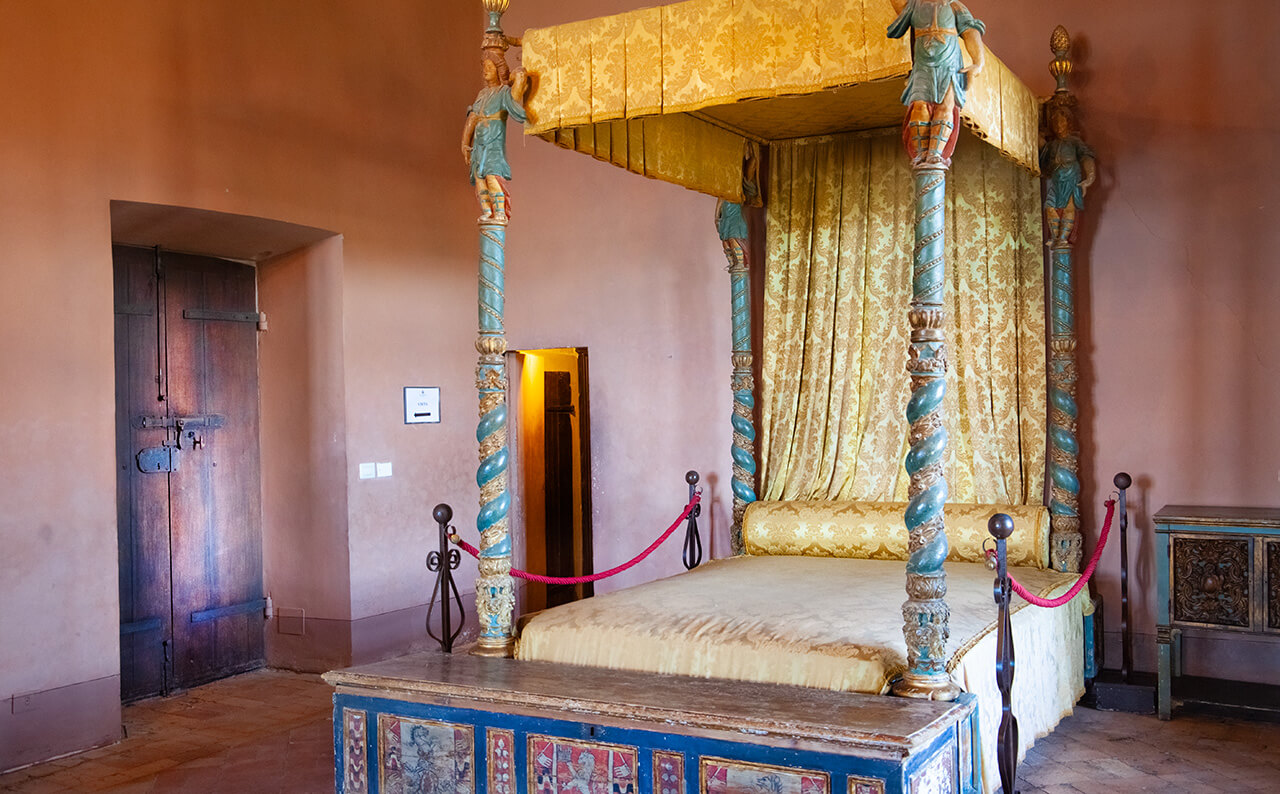
The story took a dramatic turn as Isabella allegedly confessed her sins to a confidante who, in turn, betrayed her secret to her husband. In a fit of jealousy and rage, Paolo Giordano Orsini is said to have strangled her during a fateful hunting trip.
These centuries-old legends have etched themselves into the lore of Bracciano Castle, forming a dark and enduring legacy of intrigue and betrayal. But there is more to these legends and stories than meets the eye, along with some recent discoveries that shed light on what may have truly happened, turning centuries-old legends upside down.
Isabella de Medici and Paolo Giordano Orsini in literature and theater
Isabella de' Medici and Paolo Giordano Orsini, the central figures of our narrative, are historical characters whose reputations have been marred by political intrigues and legends that have accrued over time. They have been portrayed in literature and theater as enigmatic and often scandalous figures, only to be slowly reclaimed by the pages of history, albeit veiled in layers of myth.
Isabella de' Medici was the daughter of Cosimo I, Grand Duke of Tuscany. She has been painted by a long historiographic tradition as beautiful and educated but with a penchant for frivolity, surrounded by a coterie of admirers and lovers.
Her husband, Paolo Giordano I, Duke of Bracciano, is the polar opposite, described as rough, arrogant, and violent, hailing from a family steeped in medieval traditions, with accusations of harboring bandits and orchestrating heinous crimes. Legend even suggests that Paolo Giordano might have taken his wife's life in a fit of jealousy.
Letters of Redemption that Changed History
In the realm of history, personal and familial correspondence stands as a treasure trove, offering us an intimate glimpse into the hidden desires, thoughts, emotions, and everyday lives of the individuals who penned those letters.
The letters are sourced from the correspondence of the Orsini family now housed at the Capitol Hill Historical Archive. This collection includes a staggering 548 letters exchanged between Paolo and Isabella, spanning the years from 1556 to 1576, the fateful year of Isabella's passing.
Through meticulous contextualization, researchers managed to reconstruct the underlying narrative, shedding light on a story different from the one we've come to know through centuries of historical accounts. These letters, taken together, unveil the truth behind Isabella's prolonged and devastating illness, dispelling the shadowy myths, and stepping beyond the confines of courtly novellas to unveil a dynamic reality of political, diplomatic, economic, and familial connections.
While Paolo aspired to make Rome their permanent residence, his family's obligations to the papacy and the administration of the Bracciano Castle kept him here. Isabella, on the other hand, lived in Florence at the bequest of her father. Fearing potential threats to his daughter from anti-Medici factions in Rome, Cosimo insisted that Isabella remain under the protective roof of their home in Florence. Therefore, while married, they mostly lived apart.
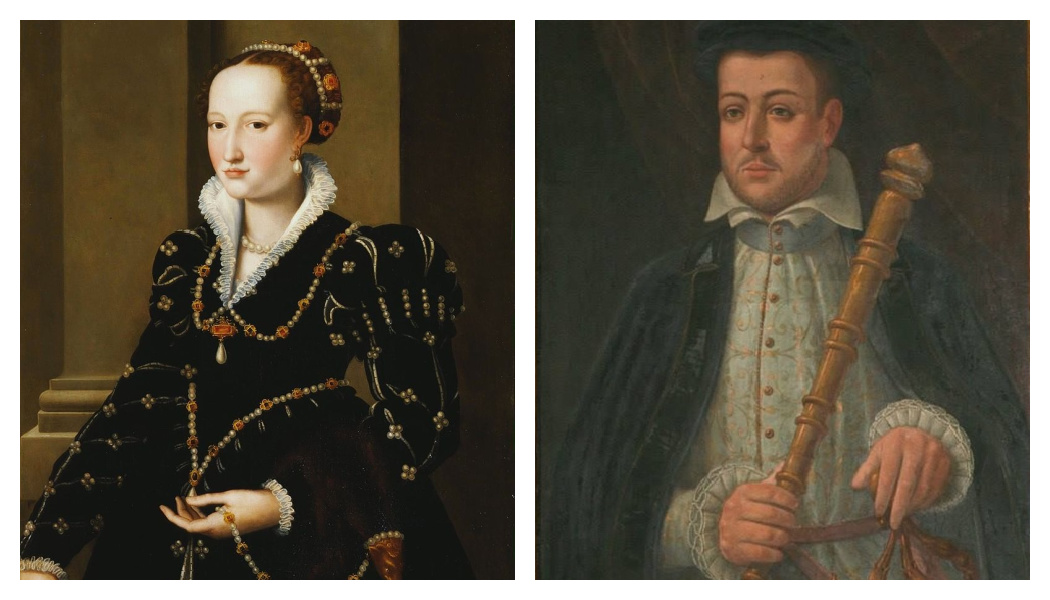
Love Letters - Isabella and Paolo Giordano in their own words
Paolo and Isabella's love story was revealed through their heartfelt correspondence due to their situation of living apart. Their letters exchanged an average of twice a week, offered a lifeline connecting Rome and Florence.
While the postal system of their time ensured efficient communication, Isabella and Paolo often opted for trusted messengers instead of ordinary mail due to concerns of interception and privacy. The content of their letters was of great interest, and they took precautions to conceal their correspondence's sensitive nature.
Yet, amid the cloak-and-dagger intrigue, Paolo and Isabella's feelings for each other were unmistakably sincere and genuine. Their letters paint a vivid picture of their passionate love, bridging the gap that the rigid procedures of marriage contracts and complex political strategies failed to anticipate.
The letters written on an average of twice a week reveal a strong marriage with words of love exchanged over twenty years, mutual reproaches for imposed separations, skirmishes and reconciliations, complicity and affection that ignite and dissipate in the daily life of a couple who appear profoundly connected. This marital reality casts doubts on the accusations of infidelity and murder.
In one of his letters, Paolo wrote to Isabella:
"I adore you, beautiful, and believe that when I die, neither children, nor the State, nor friends, nor ladies, nor anything else will I remember, except that I adore you".
Paolo's letter reflects all his emotions. "I have no one but you", he writes, "I love you since childhood".
Paolo's love was not one-sided, his letters reveal Isabella's jealousy and her constant demand for reassurance from her husband:
"I kiss your hands with the care and love you have for me, my dear, but for this, my heart, I cannot love you more than I already do, for my illness has penetrated to the bone and is, my dear, incurable".
In the same letter, Paolo writes to Isabella:
"Your words brought me great consolation, first because I heard news of you, my love, and then because I saw you dispel that bad opinion, which you wrote about in your other letters, namely, believing that I no longer remembered you, my life ... I never would have believed that the thought of believing that I no longer loved you had crossed your mind, as you wrote in your last letter. You know well that I have no one else in this world but you, and with you, I must live or die..."
In another letter, Isabella wrote to her husband: "As long as I live with you, I am yours, and I will never do anything other than what you desire."
Their letters give voice to a profound and affectionate bond that existed between the two from the very beginning, a bond that those around them could not help but notice. Paolo's friends recognized his deep love for Isabella, and their relationship was celebrated by artists and musicians during their marriage.
As time passed and Paolo and Isabella matured, their love endured and evolved. They continued to express their love, their letters reflecting a connection that was mutual, tender, and passionate. Beyond love, they became pillars of support for each other, sharing advice, opinions, and favors as they navigated the complexities of politics, economics, and child-rearing.
Isabella's letters, beginning in 1564, showcased a strong, practical, and humorous woman. She understood her role as a princess, required a blend of beauty, elegance, and political intelligence. Isabella tirelessly supported Paolo, securing military appointments and valuable connections to advance his career. Her letters also revealed her unwavering love for her husband, which persisted throughout their lives.
Their correspondence exposed their unpretentious and sincere personalities. Isabella could discern deception and falsehood, while Paolo's letters painted him as a valiant soldier and a cultured and kind person. He held deep chivalric values and courtly ideals, with an unwavering dedication to serve and protect his lady.
After multiple miscarriages, Isabella's pregnancy in the summer of 1570 marked a turning point. She gave birth to a daughter, Eleonora Francesca, in March 1571. The following year, Isabella welcomed a son, Virginio, the future Duke of Bracciano. Isabella's role as a loving wife expanded to that of a dedicated mother.
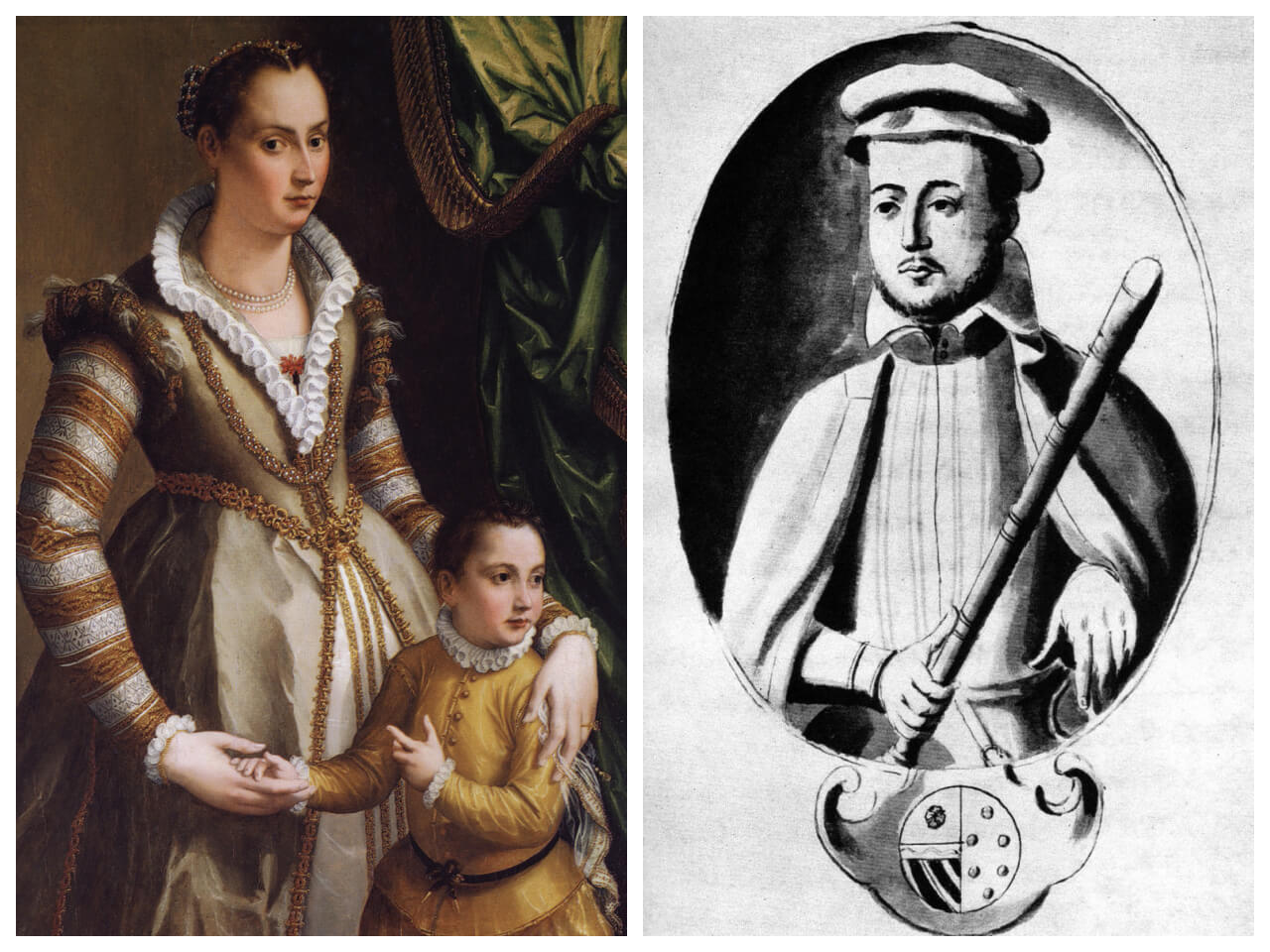
In Paolo's absence, she managed her pregnancies, the family’s legal affairs, and her brother's issues. Isabella was a practical and intelligent woman who addressed matters directly and honestly. Isabella was a practical and intelligent woman who addressed matters directly and honestly.
The joy of parenthood is evident in their correspondence, as they share their delight and happiness with each other. Isabella's letters conveyed her excitement, and Paolo, before leaving for the Battle of Lepanto, proudly showed a portrait of their daughter to all of Rome.
Isabella emerged as a remarkable woman, much like her father, Cosimo de' Medici, in her sense of duty and her ability to influence those around her. She was the ever-efficient and tireless daughter who cared for her ailing father, Cosimo de' Medici, in his time of need. Until her death, Isabella served as the emotional anchor of a family in disarray, the pillar upon which everyone relied.
Was Isabella de Medici Murdered by her husband Paolo Giordano Orsini?
Contrary to the traditional narrative of Isabella's murder by her husband, the wealth of documentation in their shared letters challenges this version of events. Reliable testimonies are notably absent, and a considerable body of evidence highlights the general awareness of her serious illness leading to her death.
References to Isabella's health issues can be found throughout her letters, with increasing concern for her well-being from 1574 onwards. In their correspondence, it was implied that she suffered from obstruction, possibly related to her kidneys, intestines, or uterus. Regardless of the specific ailment, Medici diplomacy worked diligently to conceal the severity of her condition, much like they did with Cosimo's illness.
Isabella de Medici's ongoing illness
In August 1574, Isabella experienced her first severe hemorrhage, which hinted at uterine obstruction. Her condition was accompanied by months of intermittent fever. Doctors prescribed laxatives and exercise, and Isabella's letters documented her struggles with her illness.
In September 1575, Cardinal Ferdinando, for the first time, mentioned the possibility of dropsy, a condition characterized by severe fluid accumulation in the body. This ailment often had disfiguring effects and could lead to death in severe cases.
References to Isabella's health issues are scattered throughout letters, but it's from 1574 that growing concerns for her intensify. In August 1574, Isabella experienced her first severe hemorrhage. On October 8, 1575, Grand Ducal physician Bartolomeo Gatteschi Strada expressed deep concern about Isabella's health, following a new hemorrhage. The doctor’s report mentioned obstruction - either kidney, intestinal, or uterine.
From this point on, the master of the house, Jacopo Bonaparte, reported months of intermittent fever. In February 1575, Ambassador Ercole Cortile informed Alfonso d'Este that:
"Lady Isabella has been suffering from continuous fever for several days now, although it's somewhat slow, many don't think it's such a mild illness".
In March, Isabella herself wrote to her husband: "I have a good day and a bad day. On a bad day, I stay in bed, and on a good day, I take walks because the doctors say exercise is necessary. My illness is all uppilation, which began in August and still afflicts me. They bled me with eighteen ounces of blood from my feet. Now they prescribe laxatives, and then they want me to go to the villa for exercise. I hope this helps me; this is why I haven't written because when I lower my head, I get such dizziness that it makes me lose my sight entirely, and that's why I've been neglectful."
Her condition remained fragile, despite occasional improvements. The Este ambassador reported her illness deflating and then regressing, with doctors expressing doubts about the mildness of her condition. Isabella's health continued to decline, leading to her becoming unrecognizable to those who knew her.
Despite her illness, she maintained a sense of humor and even downplayed her condition, often employing her trademark irony. She continued to engage with family and friends, even as her health worsened. In her final letter in April 1576, she thanked her husband for the mules sent for her litter, expressing her gratitude and love.
Isabella de Medici's untimely death at 34 years old
Tragically, Isabella de' Medici passed away on July 16, 1576, in the Medici villa in Cerreto Guidi. In the days leading up to her death, she and her husband had taken a walk, but her journey was cut short. Her passing was met with deep sorrow from those who knew her, and her legacy endured as a woman of beauty, virtue, and generosity.
Beyond the legends and mysteries, Isabella's story is one of resilience, strength, and unwavering devotion to her family and loved ones.
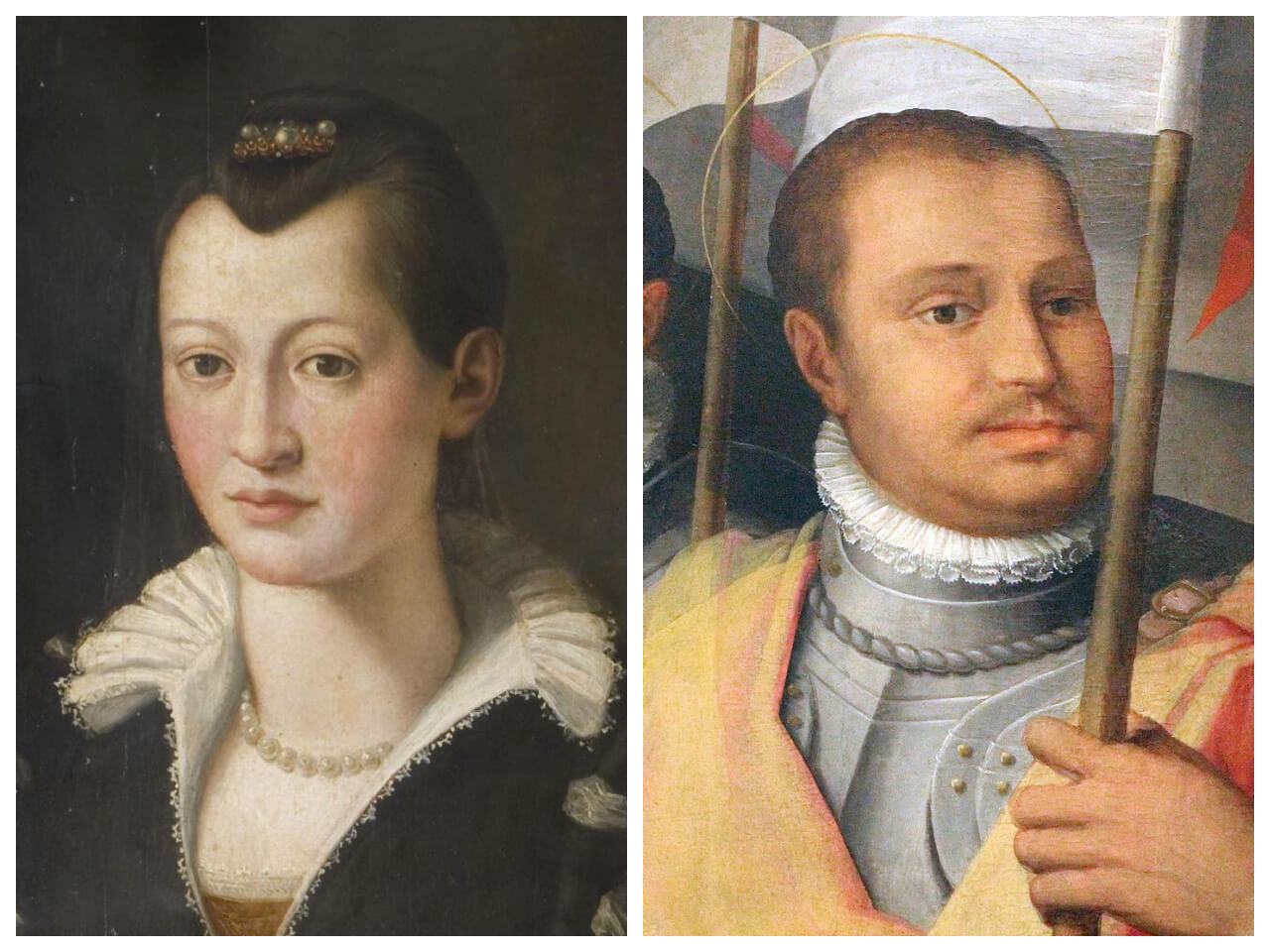
Life after Isabella: Paolo Giordano and Vittoria Accoramboni
Following Isabella's death, Paolo Giordano's life took a tumultuous turn as he became entangled with Vittoria Accoramboni, who was married to Francesco Peretti, the nephew of the future Pope Sixtus V. It is likely they met at one of Paolo Giordano's banquets held at Bracciano Castle.
The narrative took a sinister twist with Francesco Peretti's assassination in April 1581, casting suspicion on Paolo Giordano. Some sources even implicated Vittoria and her brother in her husband's death. Evading the pursuit of Pope Sixtus V, Paolo Giordano and Vittoria sought refuge in northern Italy, eventually tying the knot in April 1585. Sadly, Paolo's life came to an abrupt end a few months later in Salò.
In a bizarre sequence of events following Paolo's untimely death, Ludovico Orsini orchestrated the assassination of Vittoria. Talk about bad karma! This dark act aimed to gain control over the valuable assets she possessed, including family jewelry that Vittoria inherited as the widow of Paolo Giordano. These assets were originally intended for Paolo's son from his previous marriage to Isabella, Virginio Orsini, who stood as the rightful heir to Paolo's legacy.
Paolo Giordano's involvement with Vittoria Accoramboni stirred suspicions that he murdered his wife to marry his mistress as depicted in the 1611 play "The White Devil" written by English playwright John Webster (read more about it below).
The Legends Unveiled: Separating Fact from Fiction
Indeed Isabella de' Medici and Paolo Giordano Orsini's story is one fraught with mystery and intrigue, perpetuated by centuries of legend and rumor. To understand the truth behind this compelling narrative, we must delve into the origins of the legends surrounding this enigmatic couple.
The story begins with the death of Isabella, a woman whose passing, due to illness as we now know from the exchanged letters, became the seed for a whirlwind of false narratives.
How did the rumor of her murder at the hands of her husband gain such traction? Two factors come into play.
Firstly, the discontent of dissident Florentines played a crucial role. In a climate of political unrest, these individuals proved adept at fabricating defamatory tales about the ruling Medici family. They used this misinformation as a weapon to undermine the existing power structure.
Secondly, external forces were at play. Alfonso d'Este, among others, aimed to remove the title of Grand Duke from Francesco de' Medici and dismantle the Medici regime. Exploiting the prevailing discontent, they sought to capitalize on the false narrative of Isabella's murder, framing it as evidence of Francesco's unworthiness as the Grand Duke.
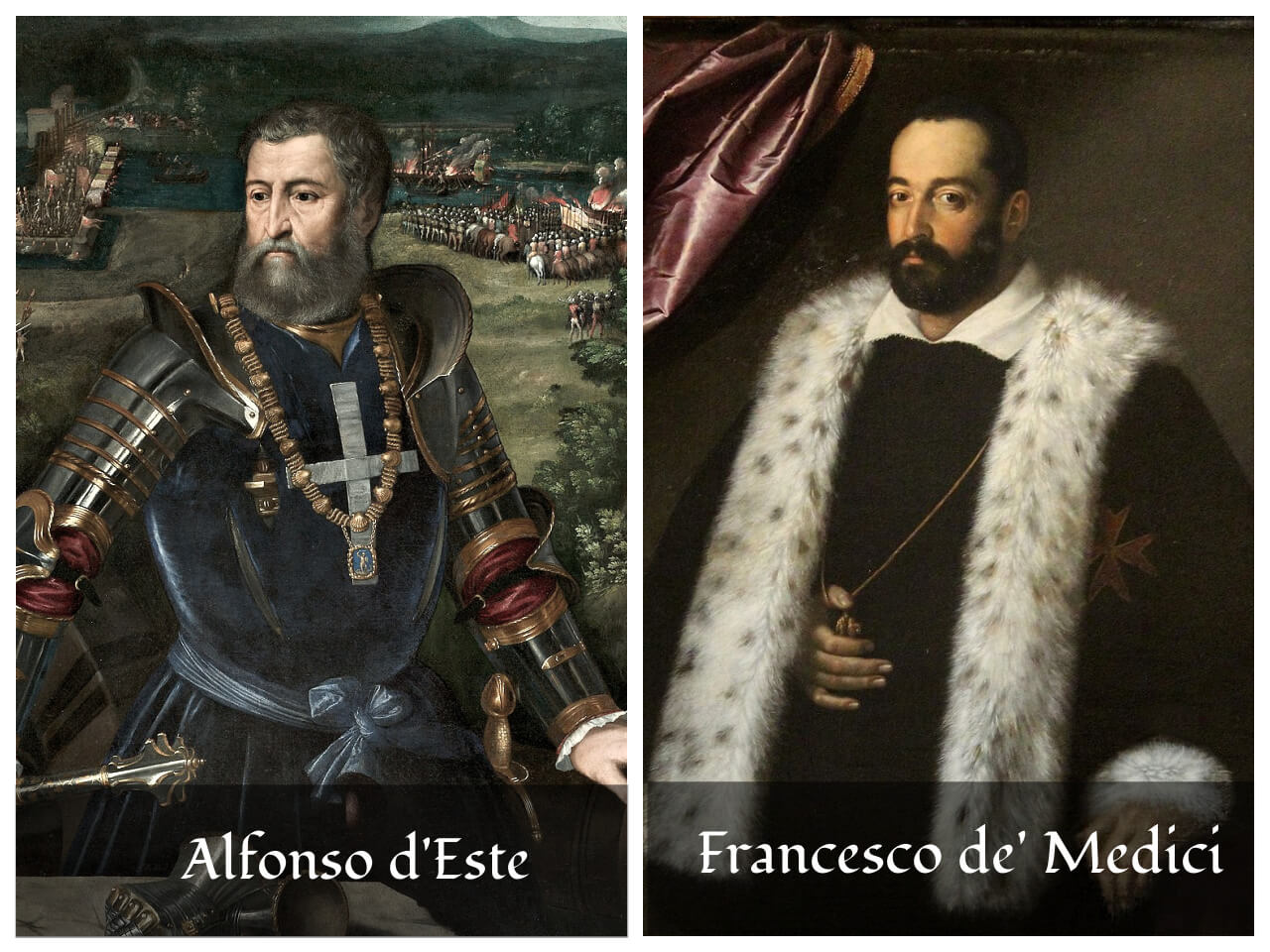
The Rivalry between the Medici and Este families
The relationship between the Medici and Este families, already strained due to issues of precedence, worsened when Francesco de' Medici was granted the title of Grand Duke. This intensified the animosity between the two noble houses.
The Este diplomat aimed to utilize the fabricated account of Isabella's murder to instigate a popular revolt against Francesco de' Medici. Alternatively, it could be used to pressure the removal of the imperial title. Various letters revealed Cortile's intentions, including a belief that Alfonso was more popular than the Medici in Florence among those dissatisfied with Medici rule.
Cortile was relentless in spreading slander about the Medici family, such as Paolo Giordano's alleged infidelity and misconduct. He also claimed that even Giovanna d'Austria was living in fear. This anonymous defamatory pamphlet, originating in Florentine circles, found its way into the Este ambassador's letters and was subsequently considered the most credible eyewitness account of Isabella's death.
Over the centuries, anonymous handwritten reports circulated, targeting not only the Medici family but also the Church in Rome, symbolized by Paolo Giordano Orsini and his family. Isabella's murder rumor continued to resurface as a political weapon. Detractors accused her of adultery, inflaming speculation about her guilt.
In the 18th and 19th centuries, historians actively sought evidence of Isabella's infidelity, driven by the spirit of positivism. Writers like Gaetano Pieraccini formulated deterministic theories regarding her supposed misconduct. However, no one refuted these claims at the time, and the legend persisted as a cornerstone of national anecdotes.
Anonymous love letters to Trolio Orsini
Fast forward to 1961, when Fabrizio Winspeare believed he had discovered tangible evidence of Isabella's infidelity: eight love letters found among the papers of Troilo Orsini, her alleged lover. These letters, unsigned and written in a different style from Isabella's, lacked dates and bore the signature "schiava in perpetuo" ("slave forever"). Yet, their attribution to Isabella remains questionable.
The power of this myth was such that it blinded and deafened, distorting sources and undermining historians' work. Scholars drew from each other's accounts and added imaginative elements, shaping a false narrative that became an unquestionable truth over time.
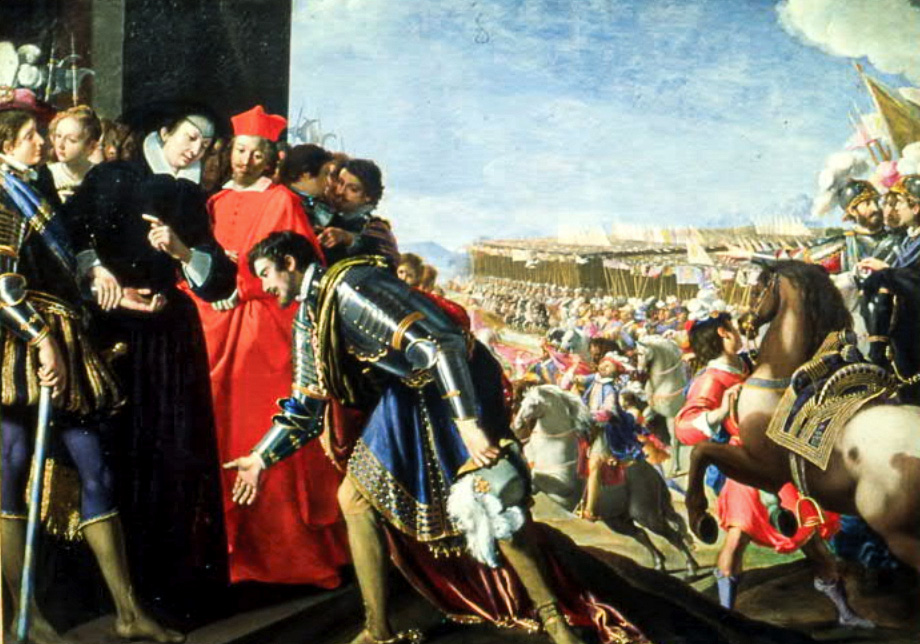
The White Devil
"The White Devil" is a revenge tragedy play written by English playwright John Webster. It was first performed around 1611, in which the character of Paolo Giordano killed his wife Isabella to marry Vittoria Accoramboni. Webster imagined that Isabella died kissing her husband's portrait which was “infected with an oil and other poisonous things".
In this play, Isabella is portrayed as a spotless woman, while Paolo Giordano is depicted as superficial and evil. Webster's sources remain obscure, but the spirit of the piece was strongly anti-papal, anti-Roman, and at the same time anti-Medici raising the suspicion that the story reached England through the channels of the Italian and especially Florentine reformists who toured Europe and had one of their privileged centers in London.
The reality, as revealed in the correspondence between Paolo and Isabella, is far removed from adultery and crimes of passion. The legends that shrowded them were steeped in slander, suspicion, political conspiracies, and concealed agendas that infiltrated the political life of Italian courts during the 16th century. The truth behind their story is, as it turns out, more remarkable than the legends that have persisted through the ages.
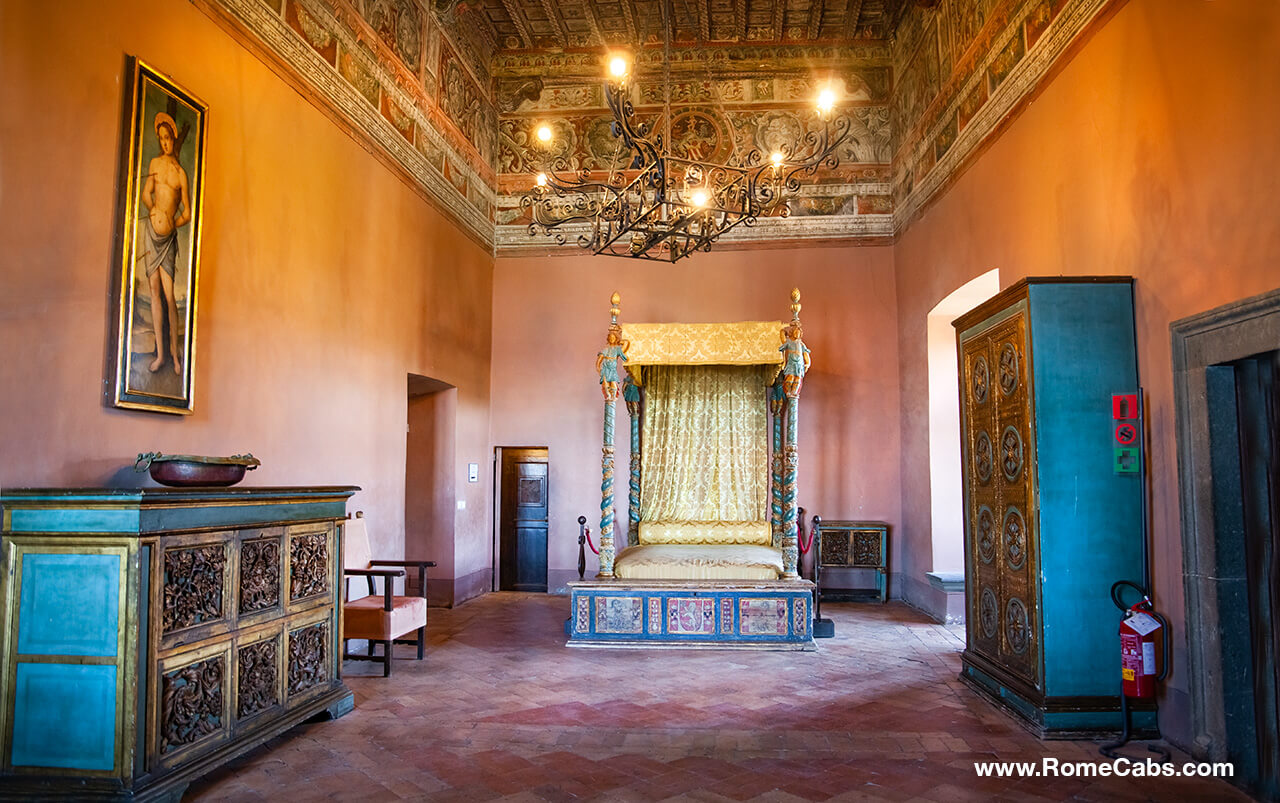
Today, as you wander through Bracciano Castle and enter the once-dubbed "Isabella's Room," now recognized as the "Hall of Orsini Frieze", you can perceive this exquisite space from a fresh perspective.
The centuries-old rumors and myths give way to a renewed appreciation for this beautiful space, inviting visitors to see it through the lens of historical truth rather than the veils of embellished tales.
Bracciano Castle, a coveted gem in the Roman countryside, features prominently in various exclusive tours we offer. Whether you're exploring the richness of Rome and the countryside in our comprehensive Rome Town & Country Tour or immersing yourself in the captivating Countryside Splendor Tour or Medieval Magic Tour, Bracciano Castle steals the spotlight.
Bracciano Castle is also a key attraction in our Countryside Pre-Cruise Tours and post-cruise excursions from Civitavecchia, ensuring the castle's timeless allure is woven into diverse itineraries for both land travelers and cruisers alike.
Thank you for reading our travel blog "Bracciano Castle: Isabella de Medici and Paolo Giordano Orsini - love, betrayal, murder, legends" and for choosing RomeCabs for your best tours in Italy. We look forward to showing you beautiful places in bella Italia!
* Find us online also on:
- RomeCabs FACEBOOK
- RomeCabs PINTEREST
- RomeCabs TWITTER
- RomeCabs INSTAGRAM
- RomeCabs FLICKR Photo Gallery
- Recommended on Cruise Critic
